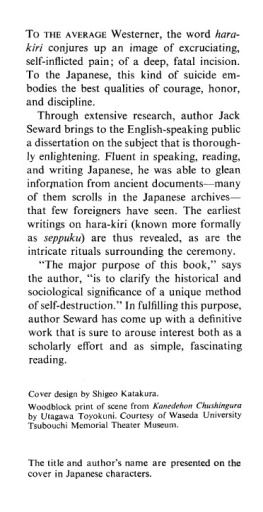ACKNOWLEDGMENTS
I want thank the following persons and organizations for their assistance in research and providing the photographs and illustrations herein:
Kazutsugu Araki, Peter Berton, Faubion Bowers, Rachel Britt, Jo-Ann Cody, Glenn Davis, Ken Edge, Education Committee of Minami Arima in Kyushu, Harry Fukuhara, Tom Fujimoto, Hoover Institution, John Hyde, Sue Lindy, Teruo Masaki of the Tourism Section of the City of Kamakura, Yoshikazu Matsuda, Toshiku Matsumura of The East , Amy Meeker, Keizo Mitsuma; Chikyo Oishi of the Bukko-in (Temple) in Kyoto, Mitsuko Sankey, Mihir Sapru, Jim Shaw, Shukan Shincho, Vaughan Simmons, John Stephan, Toshiaki Tokai (Director of the Nagasaki Prefectural Library), E. Shane Weaver, and Alvin Yudkoff.
Again, my thanks.

CHAPTER ONE
Lionhearted Women
In the West we have too often tended to the extreme view of the Japanese female: a piteous creature completely subservient to the male of the species, who has no rights, only duties, and whose life is dominated by three masters: her father, her husband, and (in her old age) her eldest son. However, there have been exceptionsand some startling ones.
In 1945 Americans arriving in Japan learned that a Japanese woman walked three paces behind her husband when outside the home, and that a husband could divorce his wife simply by submitting a written statement of divorce consisting of only 3 1/2 lines (called a mikudari-han).
Her position seemed analogous to that of the Indian woman in the old following anecdote:
One hot summer day a white man came upon an Indian brave of the Cheyenne tribe riding comfortably along on his horse with his attractive wife stumbling behind in the dust.
"Why isn't your wife riding, Chief?" asked the shocked white man.
The brave's reply was eloquently to the point: "She no got horse."
The Japanese woman's chief aim in life was to bring comfort and happiness to her husband, to his parents, and to her children. She was the first to rise in the morning and the last to climb wearily between the futon at night. She stood at the end of the line for the tastier dinner dishes. And in mixed company she spoke only when spoken to.
"If you fall in love with your wife," Japanese men were cautioned "you will spoil your mother's servant."

ONCE IN TOKYO I relayed a dinner invitation from a visiting American to a mutual Japanese acquaintance.
"Mr. (Smith) would like to invite you and your wife out to dinner tomorrow night."
"I would be delighted to accept," said the Japanese man, who I knew to be exceedingly fond of the woman we might have called his better half. "But why my wife? Why on earth should he want to invite her to come along?"
Well, all that has changed, they tell us, at least for the most part. As the Japanese are forever sayingafter the war, two things became stronger: women and their stockings.
But by no means were all Japanese women mere "child-bearing house-cleaners" who turned the other cheek and suffered in silence.
In the fourth century AD, for example, the Empress Jingo led an army in a successful foreign conquest (of part of Korea), a feat that no Japanese man was to match for 1,600 years. In ancient Chinese records we find the comment: "The Japanese formerly had kings but after years of civil war, they agreed to crown a woman named Himeko as their sovereign. When Queen Himeko died, a great mound was raised over her and more than a thousand attendants followed her in junshi (sacrificial death). After that, a king ascended the throne, but the people would not obey a man, and civil war broke out again. A girl of thirteen named Iyo was then made Queen and civil order was restored."
In the late twelfth century, there arose the Lady Masako Hojo, surely one of the most competent and strong-minded women of any age or country. On the night of her wedding to a Taira governor, she eloped with the renowned warrior Yoritomo Minamoto and ruled Japan at his side until his death in 1199. Thereafter, as the omnipotent Ama Shogun (Nun General), she continued to wisely control national affairs until her own demise in 1225.
And while not of such historical prominence, there have been more than a few other women who were remarkably lionhearted and steadfast in their policies, affections, and beliefs.

BY WESTERN CALCULATION, O-Shichi was only fifteen years old when the combination shop and residence of her father, a vegetable dealer in Komagome on Tokyo's northeast side, burned to the ground. Until he could rebuild, her father was forced to lodge his family with relatives, and the somewhat plump O-Shichi was sent to stay in the Enrai Temple in nearby Koishikawa (with a priest who was related to her family).
While in the temple, O-Shichi, whose name was written Honorable Seven, met and conceived a grand passion for a fifteen-year-old boy, Sahei Yamada, a samurai's son who roomed in the temple because he and his stepmother were always at each other's throats.
Sahei and O-Shichi felt an exhilarating attraction for each other, and their romance progressed famously until that black day when OShichi's father moved into his new shop-house and summoned his daughter to rejoin her family.
Because Sahei's father was a samurai and O-Shichi's was a mere vegetable monger, the couple entertained almost no hope that their dreamed of union would ever receive parental approval. O-Shichi pined away in her loneliness until the night of December 28, in the year of 1682, when a perfectly splendid idea burst upon herlike unto a revelation from on high.
If the fire in her father's shop had been the original cause of OShichi's being sent to the Enrai Temple and meeting Sahei, why wouldn't the same cause bring about the same effect again? Good thinking, that.
A girl of great determination, the well-rounded O-Shichi wasted no time touching a torch to the new shop. With this act she preceded Mrs. O'Leary's cow in Chicago by some two-hundred years.
However, the fire spread and burned half of Edo (the early name for Tokyo) to ashes, one of the most devastating conflagrations in Japanese history.
O-Shichi was apprehended and prosecuted, but the kindly magistrate took pity on her youth. He offered her a way out. All she had to do was to affirm in court that she was only fifteen; the magistrate could then give her the much less severe punishment meted out in such cases to persons that age or younger.
However, there was a catch. According to the Japanese way of counting age, O-Shichi was seventeen. She was one year old the day she was born and turned two on the following New Year's Day, even though New Year's Day may have come only a week later.
The local ward master also tried to come to O-Shichi's rescue by declaring (falsely) before the magistrate that his records showed her to be a minor (fifteen or under). But poor, honest O-Shichi did not catch on to the ruse. She steadfastly stuck to the truth, leaving the magistrate no choice.
His sentence on O-Shichi was appropriate, if harsh. After being paraded on a horse through the narrow streets of Edo for hours, she was taken to the public execution grounds in Suzugamori, where, for the crime of destroying half the city by fire, she was burned to death at the stake.



















